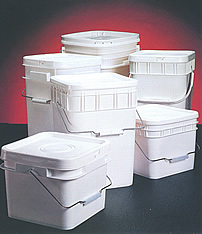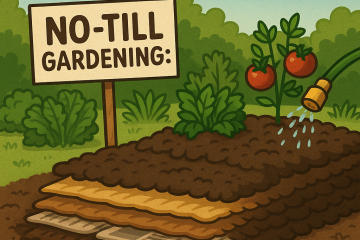
4 gallon square buckets take up less space and are easier to stack and carry
Yes, there is a relatively panic-free way to approach having a sufficient supply of food for everyone I intend to feed. I’m sure you’ve heard the saying that the best way to eat an elephant is over easy, right? Just kidding. The best way to eat an elephant is one bite at a time; so I’m going to share with you a few of my methods of attacking a chore that might otherwise seem a bit overwhelming to the point of paralysis. I believe you’ll find these suggestions helpful regardless of where you are in your own preparedness efforts.
12 Month Supply: First of all your end goal should be having one year’s worth of supplies regardless of what Principle of Preparedness that you’re considering—medications, hygiene products, paper products, clothing, water, etc. Why a whole year? Because, any crisis that’s serious enough to make you start living off of all of your supplies is very likely to take at least a year from which to recover. And if it’s going to be longer than a year, you’ll need a year of ramp up time to get a full-blown garden growing for you to live off of. Earthquake, unemployment, infrastructure collapse, EMP, economic crisis, act of war, etc.—all of these instances are very likely to take at least a year to recover and restore life back to “normal”—if that soon. (The EMP studies give an estimation of three years minimum to get the power turned back on.)
Break It Down Into Meals: When folks are just starting out, I suggest that they come up with 30 recipes for the meals that you know your family loves and that you have everything you need to make that meal 12 times. You can change that number as you see fit though such as 15 dinner recipes made 24 times, etc. I like the 30 dinner recipes minimum, to create 12 times in order to avoid running into appetite fatigue—you know, getting tired of the same thing again and again. Regardless, break down your task into meals. The more familiar you are with the meals and the more your family likes your meals the less stress it will be for you, and I’m sure we can all agree that less stress amidst a crisis is preferred.
Start With Breakfast: When I first got started with the Food aspect of Preparedness, I focused first on just ONE meal a day for the year—breakfast. Breakfast is a relatively easy meal because, just as we do in our normal life, everyone usually has a limited, comfortable repertoire for their breakfast menu. You know—pancakes, oatmeal, crumb cakes, scrambled eggs, yogurt, easy quiches or breakfast casseroles, toast and fruit, etc. Breakfast doesn’t take as many ingredients or as much thought as dinner does—at least not in my experience. When I first started out, I focused solely on having enough breakfast items first. I can’t tell you how relieved and happy I felt when I finally achieved having 365 breakfast servings for each person I planned on feeding for a year and you will too when you get to that moment where you can just cross that off your list. Worst case scenario, I knew that I had hearty, stick to the ribs, calorie dense meals to start off the day.
Then Dinner: Next are your dinner supplies. After reading several historical accounts in which food and other resources were scarce such as during the

4 gallon square buckets make organization so much easier
Depression, Europe during WWII, and way of life in 3rd world nations, I realized that 3 meals a day may be more of a luxury. So, the next thing I focused on completing was a year’s supplies of dinners based on the 30 recipe strategy mentioned above.
It’s actually really simple to put all of the ingredients for a particular dinner in a square, 4-gallon bucket with a tight fitting lid. My husband will frequently come home and say “Honey, what’s for dinner?” and I’ll simply direct him to just go select a bucket. Not every meal works out this way, but a lot of them sure do. For example, I’ve just created a new recipe for my upcoming cookbook that uses the ramen noodles (not the seasoning pack that comes with them), canned beef chunks, some seasonings, and some freeze-dried veggies. So I have everything I need but the freeze-dried veggies in the bucket, including seasonings and I’ve taped the entire recipe with clear packing tape inside the lid so that even if I’m not around to make the meal, someone else can easily follow my directions with majority of the ingredients right there. (I don’t include the veggies because they stay best, unopened, in their original #10 can. I regularly use the ingredients in the cans and mark the ones that are open and just rotate through them.)
My rule of thumb to everyone is that they should have all of the shelf-stable fixings for the favorite “Birthday Dinner” of each member of their family. I haven’t managed to conquer Lobster Stew quiet yet, but for the most part, there’s not a “favorite” meal of my household and family members that I haven’t been able to make from shelf-stable foods. That will make you happy and less stressed in making it, and it will make the rest of your family less stressed when they eat it.
Now the Luxury of Lunch: As I got the dinner needs met for our family for a year, I then started expanding to easy snacks and meals that I could throw together for lunches that didn’t require any effort other than perhaps warming something up. Hearty soups, chicken salad on crackers, ham salad sandwiches with Swiss cheese, open-faced pizza sandwiches on homemade wheat bread, hard boiled eggs and fruit, etc.; nothing too glamorous. (I can also rely on “leftovers” so long as I can safely preserve the leftovers from breakfast or dinner.)
Create your lunch menu with two things in mind—conservation of physical energy combined with a high calorie count—because if we were to ever find ourselves in a TEOTWAWKI scenario, we’re going to be worn out from all of the physical labor that will be required of us just to keep the household running. Doing laundry by hand, gardening, tending to animals, mending clothing, etc. When I read of all of the things that my great-great grandmother got done in a day, I’m amazed she was anything more than skin and bones. This kind of work will require a minimum of 3,500 calories each day just to maintain body weight. For the more labor-intensive chores which my husband is more likely to be doing such as cutting firewood, butchering, mending fences and shelter, security measures, etc., the body will require a minimum of 5,000 calories per day just to maintain body weight. So keep this in mind when you’re creating menu items. Remember though that there is a difference between empty calories and calories that do a much better job at fueling the body. I’ve invested in premium quality powdered greens, sprouts, whole grains, and legumes to provide quality calories for the body now as well as in the future.

Southern Chicken and Wild Rice Casserole
Familiar Foods: Having the supplies you need is just one component of successful Food Preparedness. Being sure that your family is familiar and comfortable enjoying those foods is the other half and it’s CRITICAL! Just as the saying goes “10 minutes before the prom is not the time to learn to dance” it also hold true with trying to feed foreign foods to your family members—regardless of whether or not they are 4 years old or 40. Like it or not FOOD is a comfort and the period of time in which you’re enduring stress and uncertainty is NOT the time to spring “healthy sprouts” and scrambled eggs from a powder. Not only will your family be much more receptive to foods they know, but the person who prepares them will be much less stressed. I can tell you that when it’s time to feed the stressed out masses is not the time to try working with the foods you’ve never prepared before. Talk about stress! That’s enough to stress me out today with all of the technological comforts that I have to enjoy, let alone when you don’t know when the next paycheck will come around, or when the roads will be open for travel again, or when the power might come back on. Having the familiar foods on hand will also help you ease into using some less familiar foods. For example, I love to make “wheat meat” aka seitan, but making a chili or a taco soup using wheat meat exclusively is a disaster in the making for several reasons, not the least of which would be the digestive discomfort that’s sure to follow. Instead, start adding wheat meat into your soups or casseroles a little at a time now so that not only does the family come to enjoy the health benefits of it, but they can also slowly get acclimated to the taste.
Comfort Food: Last but not least, let’s be sure to remember to have on hand the supplies necessary for providing your family with comfort foods. You think you need a “drink” after a long day at work at the office now? Wait until you have a day in which your basement is flooded, or you missed every 4 legged morsel of food that you tried to shoot, or the day that you barely escaped demise at the hand of looters and marauders. Whether it’s a special savory dish, sweet dish, favorite drink concoction or homemade cookies, you’d best be prepared to have a years supply of “self-medication” available for your family.
P.S. You can get square buckets at bakeries used for a great price, if any at all.


